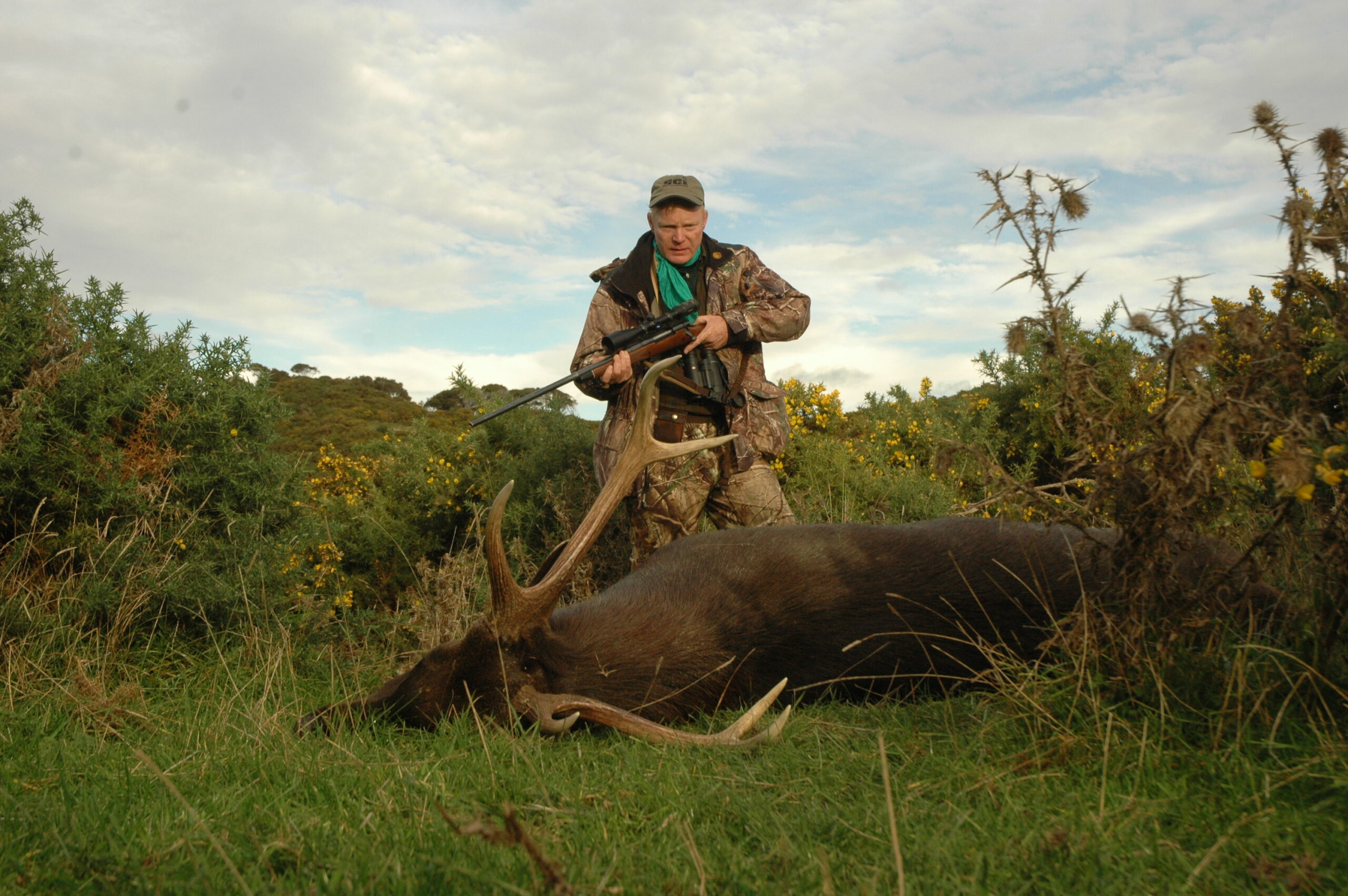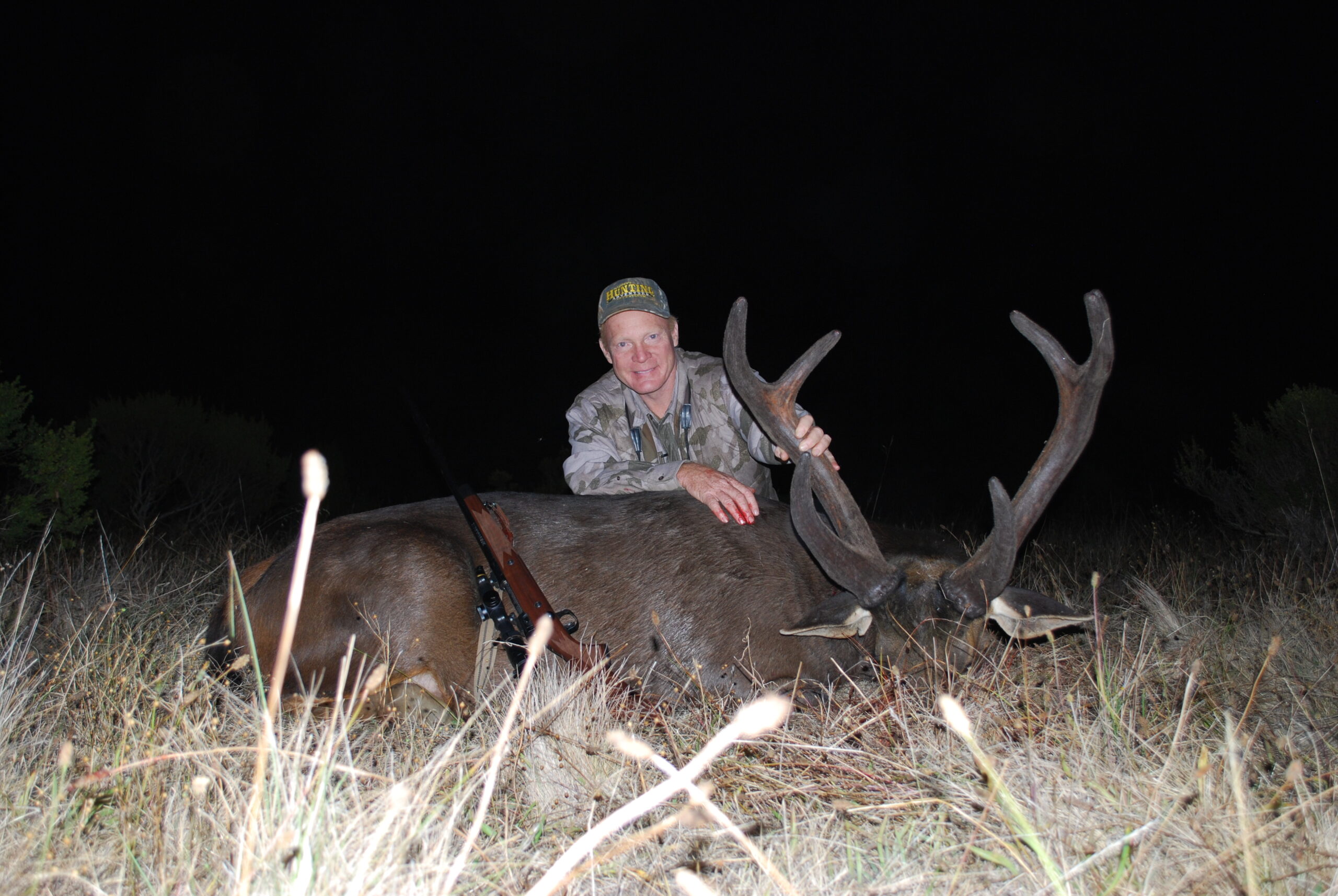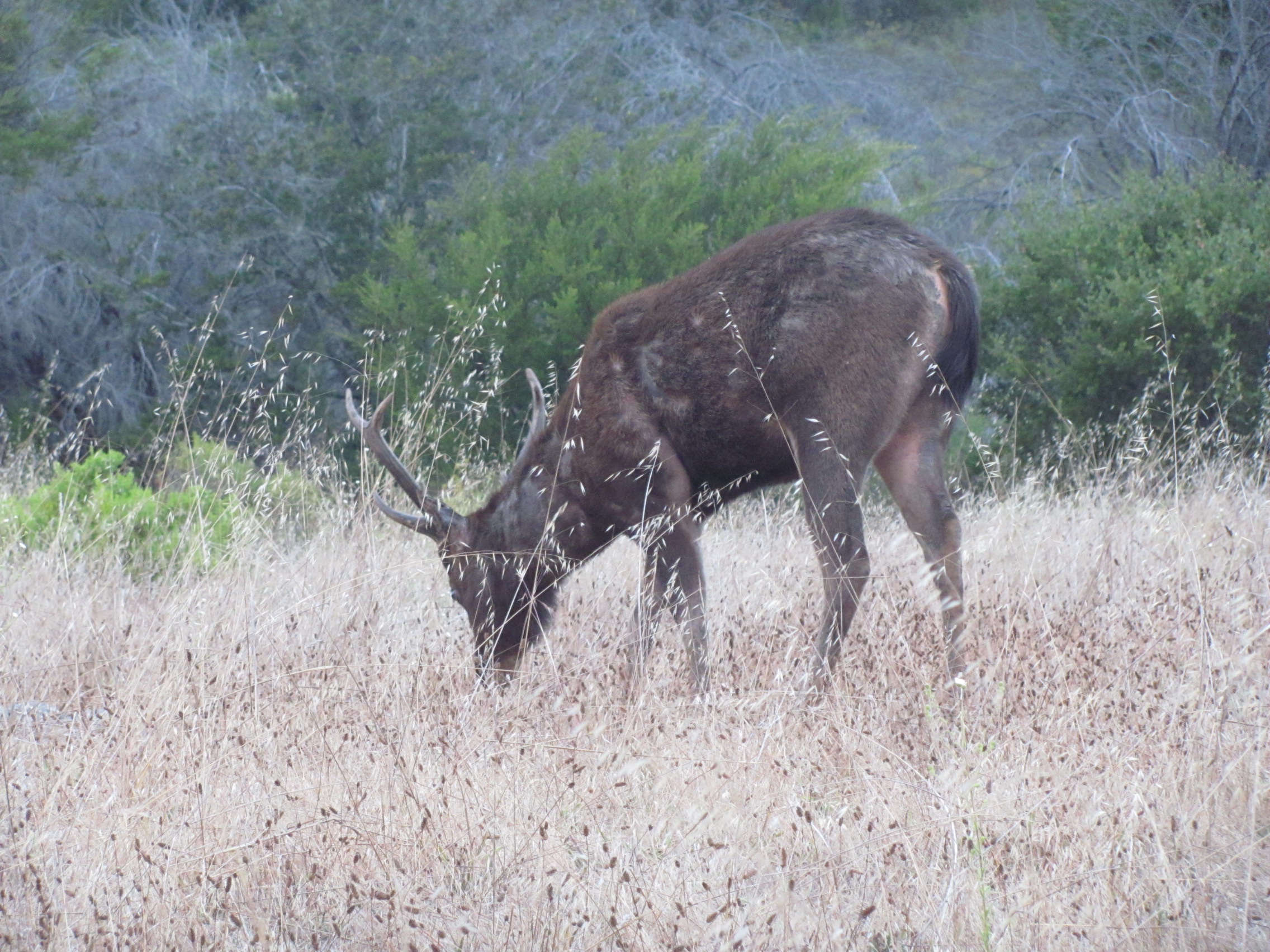World’s Coolest Deer?
According to Boddington, it’s not a whitetail, mule deer or red deer. It’s a …
By Craig Boddington
Romantics say, “Absence makes the heart grow fonder.” We hunters say, “Failure makes desire stronger.”
Long before I saw one, I thought the sambar was a magnificent deer. Partly for its appearance: it is a big, dark, thick-chested animal with simple but elegant antlers. Partly for its hunting history.
The sambar was called “Indian elk,” associated with tiger hunting, often referred to by Jim Corbett. And by Robert Ruark, Jack O’Connor, Warren Page and previous generations who were able to hunt the Indian subcontinent.
Unlike all too many legendary lost animals, the sambar is neither threatened nor endangered. Although many local populations are diminished and vulnerable, the sambar still occupies a vast range from India and Sri Lanka east across southern China, then south almost throughout Southeast Asia, including the Malay Peninsula, Borneo and Sumatra.

Boddington’s South Pacific sambar was taken in the southwest corner of NZ’s North Island, not far from the original release site in the 19th century. Although no giant, this is a nice typical sambar, taken with a .300 H&H and a 200 grain Sierra GameKing.
In my hunting lifetime, there have been few opportunities to hunt native range sambar. Not because deer populations wouldn’t support it but because legal sport-hunting opportunities have been scarce throughout this vast region for the last 50 years.
Fortunately, sambar were successfully introduced into both Australia and New Zealand in the 19th century and into the United States in 1908. All three countries offer opportunities to hunt sambar, both free-range and estate. The largest population and largest range is in southern Australia, primarily Victoria, but in recent decades, spreading to New South Wales, Queensland and South Australia.
Australia’s total sambar herd approaches 1 million, with an annual harvest exceeding 50,000, an important recreational resource and meat source.
There’s a line in our SCI Record Book: “The sambar is an outstanding game animal, the finest deer in southern Asia and the most difficult to hunt.”
I’m certain this was written by my old friend, Captain John Brandt (1927-2013), a principal creator of our record-keeping system and a longtime holder of the Asia chair. As a U.S. Navy medical officer, he spent most of his career in the farthest-flung outposts of Asia and was one of our greatest authorities on Asian wildlife.
Shy, wary, secretive and mostly nocturnal, as John suggests, hunting sambar is one thing, taking a good stag quite another. As with most hunters today, my first experience was in Victoria, hunting with the late, great Australian outfitter Bob Penfold. The first evening, we set up over a wallow.
Amazingly, just at dark, a big stag drifted out of the trees. I will never forget him. Bigger than a horse, blacker than the closing shadows. God knows what his antlers might have looked like because he didn’t have them. He was a cast stag, pedicels thick as liter Coke bottles.
RIGHT TIME AND PLACE
We saw a few females, no more males, no shots fired that trip, which is sort of par for the course with sambar. That was a long time ago, in April. There are many more sambar in Australia today than there were back then. Hunting remains difficult and iffy but more successful today. Depending on the area, hunting is open year-round.
Often, there is no bag limit because the government intends to remove as many as possible to control both numbers and range expansion. So far, the deer are winning, increasing and expanding. On the ground, the odds remain with the sambar.
Serious Aussie sambar hunters — of which there are thousands — vary in opinion on the best times to hunt them. As with all secretive animals, it depends on the weather, the moon, food sources and luck.
All of that is complicated with sambar because, like various other tropical deer (including axis), the sambar is sort of on its own schedule for antler growth. Some periods are undoubtedly better than others, but at any given time, a percentage of stags will be in hard antler, while other stags will vary from bare pedicels to any stage of antler growth.
Another time, also in Victoria, I had a shot at a stag with a nice three-point antler on his left, his right antler a long, skewed spike jutting out into space. By then, instigated by my friend Penfold, I was on a mission to take all the South Pacific’s huntable species.
Of course, I wanted them all free range, described by Penfold as “wild and free.” I wasn’t there yet, but I was getting close. Everything in me knew that I should take that weird stag. I hesitated — he wasn’t my dream sambar. The moment was lost as he vanished into thick stuff. Naturally, that made me want one even more.
Research suggests that winter months, May through August, are probably best. Not necessarily (though possibly) for a higher percentage of stags in full antler, but because there’s more winter rain, so the ground is wet and quieter for stalking.
On the other hand, equally good sambar hunters tell me October and November are good because groundwater has dried up, and stags go to dwindling wallows. Truth is, I don’t know. Getting a good chance for a sambar takes research, planning and some amount of luck.
The sambar wasn’t my only problem in the South Pacific. It took me multiple tries to get a free-range hog deer on Victoria’s southern coast, and that deer has a set season in April. So, my attempts to get a sambar in Victoria were in April, which was convenient and possible but likely not an ideal time.

Then, my real nemesis became a good old whitetail deer. There were just two free-range populations, both on New Zealand’s South Island: The Glenorchy herd, north of Queenstown near the head of Lake Wakatipu; and Stewart Island off the southeast coast. Stewart Island is probably best. It certainly has the larger population. Managed on a block system, it’s difficult for outsiders.
So, I tried several times north of Queensland. Also, April is theoretically a good time for whitetail, also a good month to be in New Zealand, with red stags roaring. A whitetail seemed almost impossible, with thick cover, few deer and heavy local meat hunting.
I passed a couple of spikes and hoped they’d survive and grow up. Outfitter Chris Bilkey set up one more attempt, this time a bit later, in mid-May. As before, things were looking hopeless and then a nice buck fell into my lap. Always better lucky than good.
I rejoined Chris and Peg at their home in Geraldine. I had a few days to spare with only a sambar to complete my quest. Chris knew of a place, hilly farm country in the southwest corner of the North Island, inland from the original release in 1875. We scrambled and flew up there.
Farmers were raising cattle on cleared hilltops and plateaus, open pastures surrounded by valleys and deep cuts choked with jungle-like growth.
Yep, sambars were living in those cuts. The first afternoon, an hour after we arrived, the farmer — nice guy and great host, little interest in hunting — walked us across a pasture to the edge of a steep cut. We sat down, started glassing, and a few minutes later, a stag with a perfect three-point rack in bone-white hard antler stepped into a small clearing.
I’d been at this for a decade, more trips to the South Pacific than I care to think about. There he was, end game, in the open, 200 yards. Chris talked me out of it. He’d only been here a couple of times but felt certain we could do better. I was shaking my head as we walked away to glass another cut.
I was still shaking my head two days later. In passing that stag it appeared we had messed up.
It rained and was windy. Nothing was moving. As much as I trust Chris Bilkey, doubt crept in. Maybe there were sambars living in the thick stuff in every cut. Maybe there weren’t. We saw several females and youngsters, and then one more stag. But it was clearly smaller than the first one, and easier to pass.
Funny, as I’m writing this it’s May 26, 2025. On May 26, 2009, we had another wet morning, then the system blew out, and we had a clear, calm afternoon. We walked to the north end of the plateau, grassy slopes descending to a distant open valley, and found a spot where we could glass to the southwest into a series of cuts. We didn’t glass long before Chris found three sambars bedded in a narrow opening near a ridge top, thick brush just above them. Two hinds and a very good stag. Not huge, but a no-brainer.
We had to maneuver a bit to get an angle. I pushed my pack onto a grassy hump, mashed some grass out of the way — 175 yards, perfectly clear. Except: They were lying in the echelon, the stag closest, the two hinds overlapping behind him.
I had the rifle over a pack for seeming ages, trying to figure out the angle. Technically, it was a safe shot, provided I didn’t blow it and provided the bullet didn’t turn on a bone and do something weird.
I resisted temptation, waited them out and eventually they stirred and stood, the male last. I was shooting a .300 H&H with 200-grain Sierras, handloaded fast, and I’d been ready for a long time.
The instant he was clear I shot him on the shoulder. There was too much recoil to see the bullet hit. I only saw his rump as he vanished over the top. That’s where we found him, the end of a long quest.
ANCIENT HISTORY, NEW BEGINNINGS
Like so many Asian deer (axis, hog deer, rusa and sika), a typical sambar stag has a three-tined antler: Beam, brow and caudal. The second point, the caudal, is often about as tall as the beam tip. We at SCI measure them like all other deer, combining beams, points, circumferences and inside spread for a total measurement.
The Aussies, who surely shoot the most sambars today, typically think of sambar in terms of main beam length. Their Holy Grail is a sambar with (at least one) 30-inch beam. Sort of like mule deer hunters want a “30-inch spread.” In local clubs and pubs, that’s the benchmark, achieved by few.

During his late August sambar hunt in California this young stag was the only one seen in hard antler; all other males were in various stages of velvet. A serious fight is the likely explanation for his scarred body, so there must have been another hard antler stag in the area.
They ignore mass, tine length and spread. I’ll be honest: My South Pacific sambar doesn’t measure up. He’s a good stag, has decent mass, and has nice points; only an idiot would pass him. But he’s not a giant.
Nor do any current sambars come close to what once was possible. At one time, the old Rowland Ward endeavored to maintain records throughout the world. On horned and antlered animals, their system measured only the longest horn or main beam. Their largest sambar, from India in 1902, had an amazing 50-inch main beam.
We identify the sambar as Cervus unicolor (round-antlered deer, one color), with several races. Today, some authorities prefer Rusa unicolor, recognizing their close kinship with the rusa deer. However, the sambar is a larger, more heavily built deer than the rusa, with thicker but comparatively shorter antlers with more curves to the main beams. Underparts and rump may be tan or russet, but the basic color is a uniform dark brown, with older bulls often very dark, almost black. The sambar has exceptionally large and visible pre-orbital glands below the eyes, called by the Chinese “four-eyed deer.”
Regardless of which Latin name you ascribe to, the Indian sambar is the largest and earns the nickname “Indian elk.” Weights up to 1,200 pounds are referenced (if not properly recorded).
For a big, mature Indian stag, 750 pounds is more likely, the sambar thus slightly smaller than the American elk. Size diminishes significantly as you move east across China and south through Southeast Asia and drops even more in isolated island populations, such as Formosa and the Philippines.
In our SCI record-keeping, we recognize six races of sambar: India, Sri Lanka (formerly Ceylon), Indo-Chinese, Borneo (Malaysia), Formosa (Taiwan) and Philippine.
Properly, I should say, for “potential record-keeping” because since inception, our entire system has recorded just 29 sambars from Asia, and several categories have no entries. Thirteen are the large Indian sambar, mostly from the 1960s.
Our largest was taken by the great Italian hunter Dr. Carlo Caldesi in 1962, the last by Ted Boysen in 1970, shortly before India closed.
We also have a dozen Indo-Chinese sambar, mostly from southern China and a few from Vietnam. Our largest Indo-Chinese sambar was taken by the also-great Dr. Jim Conklin in China in 1994.
The last Indo-Chinese sambar in our records was taken by Richard Sand in Sichuan, southern China, in 2001. I never saw that area, but I remember the year. I hunted blue sheep in western China that spring and intended to go back for what sounded like an awesome forest hunt in Sichuan: Sambar, mouse deer and takin. It didn’t happen because China suddenly closed and remains closed.
Since then, opportunities to hunt native-range sambar have been scarce. I saw a sambar in Luzon in the Philippines 10 years ago, but it was not free range, so I passed.
Erich Mueller of Hunt Geo has opened hunting in Borneo, the only current native-range opportunity I’m aware of. These are smaller sambar and difficult jungle hunting, but a few have been taken, including one by the indefatigable Rex Baker in 2020.
Currently, introduced populations offer the best opportunities to hunt sambar. Our records include more than 300 sambar entries from the South Pacific, so that’s clearly the best and most likely opportunity.
Australia’s southern population is expanding, and there is a small free-range population on the Cobourg Peninsula. Both Australia and New Zealand’s North Island have sambar in estate and free-range situations. Take your pick.
Although the sambar was commonly hunted in India because it closed so long ago — before our record-keeping system was created — our sampling of the big Indian sambar is small. The initial release into Australia’s Victoria appears to have been from Ceylon, now Sri Lanka, in 1861. The Sri Lanka sambar may not be quite as large as the Indian race. However, other South Pacific releases were from India (then part of the Empire, right?).
A century and a half (and many Cervidae generations later, habitat plays a role. Both Australia and New Zealand produce large sambar. Our SCI world record South Pacific sambar (free range typical), taken by Michel Bergerac in Victoria in 1984, would be in sixth place in SCI’s native range Indian sambar listings. Finally, let’s not forget our introduced populations here in the U.S.
AN ALL-AMERICAN SAMBAR
Sambar were introduced onto Florida’s St. Vincent Island in 1908. An annual hunt is held to manage the herd, permits by drawing, archery only. Although uncommon, some Texas ranches have sambar, so estate hunting is possible. Little-known is a small but seemingly stable free-range herd on California’s Central Coast, not far from where I live. It was likely introduced by William Randolph Hearst a century ago. My old friend, local outfitter and taxidermist Don Anderson has maintained private land permission for some years and does a few hunts annually.
In California, non-native deer can only be taken during the state’s official deer season. On the Central Coast, deer season comes early, archery starts in July and rifle season runs from early August to later September. At this time of year in this area, most stags seem to be in heavy velvet so later in autumn would be better, but the season is what it is.
The deer spend the long, hot days bushed up in dense thickets, with most movement during a short morning hunt and just before dark. Despite the seasonal disadvantages, the hunts are usually successful, and Don takes very good stags. So, although very limited, it’s a great opportunity for a big free-range sambar.
I started to write, “It’s not an easy hunt,” but that’s not true; it depends on your luck. On the first afternoon, on our way through the hills to a cabin that would serve as camp, we spotted a good stag bedded just off the track. Heavy-antlered, Don judged him as an old, downhill stag and thought we could do better. I claim no skill in judging sambar. That stag looked great. However, naturally, I didn’t want to shoot on the first day. Often, that’s a terrible mistake. Also, naturally (and correctly), I concurred with Don. So, we left him in his bed and never saw him again. I thought about him a lot over the next few days. More than a week passed before we saw another mature stag.
As the days slipped by, we saw several females and a few youngsters. Most of the males were in various stages of velvet, just one young stag in hard antler. With long daylight, nights were short, so we napped during the heat of the day. It wasn’t a hard hunt, and our low coastal mountains are especially beautiful. However, it was a serious quest, easily the most difficult of my career for any non-native anywhere in the world. Like John Brandt said, sambar are difficult. By the time I got my stag, I wasn’t sure if we would succeed or run out of time.
Just at sunset, he fed up out of a thick poison oak-choked cut onto an open hillside. We had to cover ground quickly before we lost the light. Luckily, we had cover and the wind was good.
We closed about 100 yards, and Don put up sticks. The stag was black against yellow grass, still in velvet but fully formed, with good beams and points, wonderful mass, and an awesome stag. I was shooting a .375 and was happy for a big gun with light fading fast.
He took the bullet on the shoulder, went a few yards, and I had a fine sambar. Indian, Australian, American, a great animal, much bigger than the stag we’d seen a week earlier. I’d still love to have a native-range sambar before I’m done. Doubt I can bring India back, so I’m looking hard at that hunt in Borneo.
Col. Craig Boddington, SAFARI Magazine Features Editor, is past president of the Los Angeles Chapter, a decorated Marine and C.J. McElroy Award winner.

